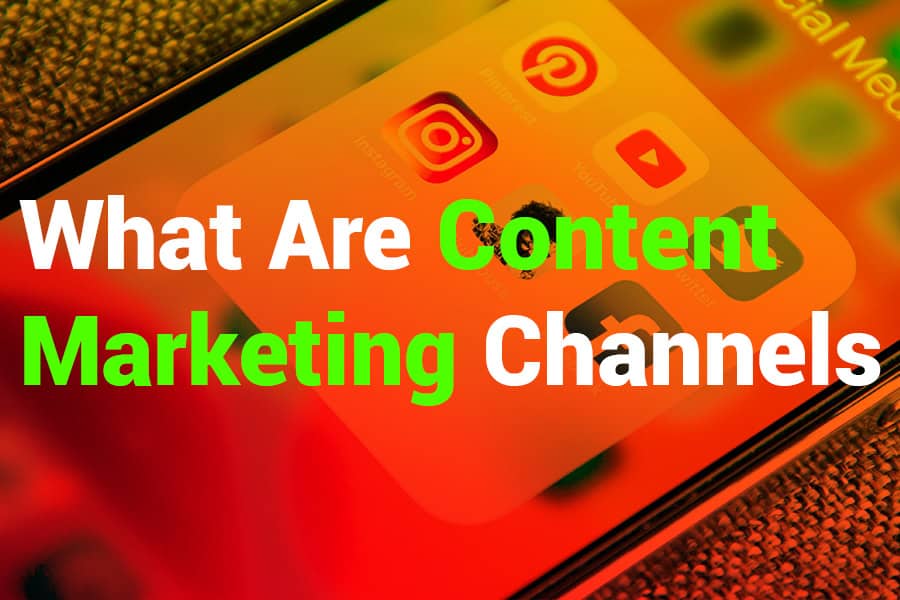
Content marketing is an essential part of digital marketing, but understanding what content marketing channels are and how to use them effectively can significantly impact your brand’s success. Content marketing channels are the platforms and mediums brands use to distribute valuable, relevant content, from blogs and social media to email and video marketing. Choosing the right channels allows brands to connect with their target audience, drive engagement, and achieve their marketing goals.
Each channel offers unique strengths, whether it’s social media’s instant engagement or email marketing’s personalization. In this guide, we’ll explore various content marketing channels, highlighting the benefits, best practices, and tips for optimizing each one to maximize reach and engagement.
What are Content Marketing Channels?
Content marketing channels are platforms and mediums brands use to distribute valuable content. Popular channels include social media, blogs, email, and video platforms like YouTube. These channels help brands connect with audiences, drive engagement, and build customer loyalty. Choosing the right channels depends on your audience, goals, and content type. For example, social media is excellent for real-time interaction, while email offers personalized, direct communication. Effective use of content marketing channels allows brands to reach their audience strategically and maximize their marketing efforts.
Why Are They Important?
Content marketing channels are the various platforms and media through which brands distribute content to engage their target audience. They play a crucial role in delivering messages, building brand awareness, and establishing trust with consumers. Each channel offers unique advantages, making it essential to understand their differences to select the ones that align with your brand goals.
Content marketing channels help brands reach audiences where they already spend time. For instance, social media channels allow real-time engagement, while blogs provide in-depth information that enhances brand authority. By leveraging multiple channels, brands can meet their audience’s needs and preferences, which increases the likelihood of engagement and retention. Ultimately, choosing the right content marketing channels enables brands to deliver content that resonates, builds relationships, and drives conversions.
How to Identify the Best Content Marketing Channels for Your Brand
Selecting the best content marketing channels depends on understanding your audience, objectives, and content type. An effective content strategy is one that aligns channels with the brand’s overall marketing goals.
Assessing Audience Preferences
To choose the right channels, you first need to know where your audience spends their time. Younger audiences may favor platforms like Instagram and TikTok, while professionals may engage more on LinkedIn.
Defining Your Goals
Identify what you hope to achieve with content marketing. Are you aiming for brand awareness, lead generation, or engagement? Each goal may require different channels.
Analyzing Competitors
Researching which channels competitors use successfully can provide insight into where your audience is most active and engaged. Analyze the platforms and content types that resonate with their audience.
Considering Content Type
The type of content you plan to create also influences channel selection. Visual content is ideal for social media platforms, while blogs work well for educational or in-depth content. By aligning content types with the right platform, you increase the chances of success.
These factors will guide your choice, ensuring your content reaches the audience most likely to benefit from it.
Exploring Different Content Marketing Channels
Content marketing channels encompass a wide range of platforms, each with its unique benefits. Here’s a look at some popular channels and how to use them effectively.
Social Media
Social media platforms like Facebook, Instagram, LinkedIn, and Twitter offer real-time interaction and broad reach, making them essential for building brand awareness and engaging with audiences.
Blogging
Blogs provide valuable information, establish brand authority, and improve SEO, driving organic traffic to your site over time. They’re ideal for in-depth topics and educational content.
Email Marketing
Email allows for direct, personalized communication, ideal for nurturing leads and providing exclusive content to subscribers. With segmentation and automation, email marketing is highly effective for conversions.
Video Marketing
Video platforms like YouTube and short-form videos on TikTok capture audience attention quickly. Video content is highly engaging and perfect for explaining complex topics, showcasing products, or sharing customer testimonials.
Podcasts
Podcasts allow brands to share insights and expertise in an audio format, which is ideal for reaching audiences on the go. They build credibility and provide a unique way to engage listeners regularly.
Using these channels effectively helps brands maximize reach, engagement, and conversions by meeting the most active audiences.
The Benefits of Using Multiple Content Marketing Channels
Diversifying content distribution across multiple channels offers several advantages, from expanded reach to increased engagement and brand consistency.
Expanded Reach
Using multiple channels helps brands reach a broader audience by catering to different preferences. For example, while some users prefer reading blog posts, others might engage with video content or podcasts.
Enhanced Engagement
Different channels provide unique ways to engage with audiences. Social media fosters real-time interaction, while email allows for personalized communication, enhancing engagement across platforms.
Improved Brand Visibility
A multi-channel approach ensures that your brand remains visible across various touchpoints. By appearing in search engines, social feeds, and inboxes, your brand stays top of mind for consumers.
Increased Content Longevity
Distributing content across channels extends its lifespan. A blog post can be repurposed into a video, an infographic, or a podcast episode, allowing brands to make the most of each piece of content.
Using multiple channels creates a comprehensive, consistent brand presence, ensuring content is accessible and engaging for various audience segments.
How to Create a Multi-Channel Content Marketing Strategy?
A successful multi-channel content strategy requires careful planning and coordination. Here’s how to build a strategy that maximizes the effectiveness of each channel.
Defining Clear Goals
Set specific, measurable goals for each channel. For example, aim to increase website traffic through blogging, build brand awareness on social media, and nurture leads via email marketing.
Creating a Content Calendar
A content calendar organizes posting schedules, ensuring consistency across channels. It’s essential for planning timely and relevant content, as well as coordinating multi-channel campaigns.
Leveraging Repurposed Content
Repurposing content allows brands to maximize their reach. For instance, a blog post can be summarized into a social media graphic or video, tailoring it to different channels.
Analyzing Performance
Use analytics tools to track performance across channels. Metrics such as engagement, conversions, and traffic provide insights into which channels are most effective and help refine the strategy.
By following these steps, brands can build a coordinated, impactful content marketing strategy that utilizes multiple channels to reach their audience effectively.
Challenges in Content Marketing Channel Management
Managing content across various channels presents unique challenges, from maintaining consistency to measuring performance effectively.
- Content Consistency
Maintaining consistent messaging across multiple channels requires planning and coordination to avoid confusing the audience. - Time and Resource Management
Managing several platforms demands time and resources. Consider automation tools or outsourcing certain tasks to streamline the process. - Measuring Success
Tracking performance across multiple channels can be complex. Implementing a unified analytics system helps consolidate data, making it easier to evaluate results. - Adapting Content to Each Platform
Each platform has unique requirements. Tailor content for each channel, such as using shorter captions for Twitter and more detailed descriptions on blogs. - Staying Updated with Trends
Trends and algorithms change frequently, particularly on social media. Stay informed of updates to maintain optimal performance.
By acknowledging these challenges and planning accordingly, brands can successfully manage multi-channel content marketing efforts.
Final Thoughts
Knowing what content marketing channels are and how to use them effectively can transform a brand’s marketing efforts. By selecting channels that align with your audience, goals, and content type, you create a tailored approach that maximizes engagement and reach. From social media and blogs to email and video platforms, each channel offers unique opportunities for connection and conversion. A well-coordinated, multi-channel strategy builds brand visibility, fosters engagement, and ensures long-term growth. As digital platforms continue to evolve, brands that adapt and optimize their content channels will remain competitive and relevant.
Frequently Asked Questions
Q. Why is using multiple content marketing channels beneficial?
A. A multi-channel approach increases reach, engagement, and brand visibility by meeting audiences on their preferred platforms.
Q. How do I choose the right content marketing channels for my brand?
A. Consider your audience, content type, and marketing goals. Research where your audience is most active and choose channels that align with these insights.
Q. How can I ensure consistent messaging across different channels?
A. Create a content calendar, use a consistent brand voice, and repurpose content for each platform to ensure cohesive messaging across channels.
Q. What tools help manage multi-channel content marketing?
A. Tools like Hootsuite, Buffer, and Google Analytics can help schedule, post, and track performance across multiple content channels.
Q. How do I measure success in content marketing channels?
A. Measure success by tracking KPIs such as engagement, conversions, traffic, and reach, then use analytics to assess performance and refine your strategy accordingly.
Jessica Jones
Jessica Jones is a talented writer at J Morgan Marketing, where she excels in creating compelling and engaging content tailored to meet the unique needs of clients. With a keen understanding of digital marketing strategies, Jessica crafts narratives that not only captivate audiences but also drive brand growth. Her expertise spans across various content forms, from blog posts and articles to social media and SEO-driven copy, ensuring that every piece resonates with its intended audience and contributes to the overall marketing goals. Passionate about storytelling and innovation, Jessica is dedicated to helping brands connect with their audience through powerful and effective content.






